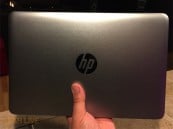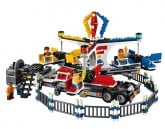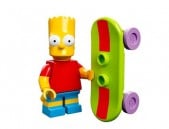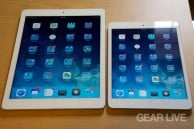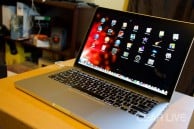Latest Gear Live Videos
Bleeding Edge TV 168: AMD vs. Intel: Chipset War

Posted by Andru Edwards Categories: Full Episodes, Gizmatic, Head To Head, High Score, Features, PC / Laptop, Video Games, Videocasts,
While hanging out in the AMD Performance Lab, Pat Moorhead sat down with us to give us a head to head look at a basic Intel G965 chipset up against the AMD 690 series chipset, focusing on gaming performance. These are the off-the-shelf computers you would buy at low cost for $500-800 or so, using integrated graphics chips. You gotta see this side-by-side comparison to see just how amazing the results of the AMD-ATi merger are.
Oh, and obviously, these tests were done in an AMD lab. However, just like it was mentioned in the Performance Lab video, if you want the scripts to do any of these tests yourself, all you have to do is ask. Drop an email to .(JavaScript must be enabled to view this email address) or .(JavaScript must be enabled to view this email address) and they will hook you up.
Advertisement
Bleeding Edge TV 167: Inside AMD’s Performance Testing Lab

Posted by Andru Edwards Categories: Full Episodes, Gizmatic, High Score, Features, PC / Laptop, Video Games, Videocasts,
While we were out visiting AMD, they gave us the opportunity to enter their Performance Testing Lab, an area guarded by dual steel doors that seemingly required both a key and special knocking code in order to enter. Once inside and sure that our lives were safe, we spoke with Mark Welker about how AMD tests their chip technologies across different platforms, software, and games. He talks to us about benchmarks, what they mean in the real world, and how they can be gamed to show what you want them to show. Even better, Mark gives out his corporate email address and offers to send the performance testing scripts to anyone who asks so that people at home can do it themselves. Just drop him an email at .(JavaScript must be enabled to view this email address) and tell him Gear Live sent you. Check the video for the full scoop.
Bleeding Edge TV 165: AMD LIVE! Digital Home Cinema

Posted by Andru Edwards Categories: Gizmatic, Short Bytes, Features, HDTV, Home Entertainment, Movies, Music, PC / Laptop, Videocasts,
We were able to get a first-hand look at the new AMD LIVE! Digital Home Cinema concept while hanging out with the AMD crew. For those who may have missed it at CES, the AMD LIVE! Home Cinema is pretty much a specialized HTPC that aims to replace just about everything in your entertainment center, save for game consoles. It can run Linux or Windows Media Center, and is even a digital cable tuner that is CableCARD compatible. Powered by an AMD Athlon 64 X2 dual-core processor, it aims to provide an immersive theater-quality media experience with high-definition video, integrated 100 watt per channel surround sound audio and Internet capability, all in a device fit for your entertainment center. Check the video for a full walk-through.
Bleeding Edge TV 164: AMD Introduces Active TV

Posted by Andru Edwards Categories: Full Episodes, Gizmatic, Corporate News, Features, Home Entertainment, PC / Laptop, Video Games, Videocasts,
Seems everyone wants to get into the business of streaming content both from the Internet and from your home network, to your television. Of course, we are of the opinion that in as little as ten years time, this will be the way most television entertainment is consumed in the first place, so it only makes sense that companies start getting on the ball now. AMD recently gave us a look and demo of their Active TV softwawre. This aims to bridge the gap between video and other content found on your home computer, along with that found on the Internet.
Bleeding Edge TV 162: Special Edition Engraved AMD Chip Awarded to Vanishing Point Winner

Posted by Andru Edwards Categories: Gizmatic, Short Bytes, Announcements, Corporate News, Features, PC / Laptop, Videocasts,
So if you have been a follower of
The Bleeding Edge for any length of time, you know that we have been following the Vanishing Point game since it started, courtesy of Windows Vista and AMD. One of the puzzles was the LOKI meta-puzzle, where the first person to figure out exactly who Loki was would win a prize. The prize turned out to be a special run of AMD processors that would be engraved with your name, or phrasing of your choice. Audrey Murphy was the first to solve the puzzle, and we were on hand when she was awarded one of her special edition chips.
Bleeding Edge TV Goes Behind The Scenes at AMD

Posted by Andru Edwards Categories: Gizmatic, Short Bytes, Corporate News, Features, Home Entertainment, PC / Laptop, Software, Videocasts,
We went down to AMD headquarters in Austin, TX to take a look behind the scenes at AMD. The chipmaker gave us access to just about anything and everything, and the result is a series of videos that just might change the way you think about the company that grew to give Intel a run for it’s money. Here is a list of the content you will see appear over the next few days:
- Inside the AMD Performance Lab
- Winner of Vanishing Point Meta-Puzzle Awarded Plaque
- The Difference Between AMD and Intel Approaches to Quad Core Processing
- Head to Head: Intel Chipset vs. AMD Chipset In-Game Performance
- AMD Live! Digital Home Cinema
Plus we have a few things that we can’t even show you for another week or so, but we are sure that you will enjoy everything we have put together in this series of videos. As pieces are published, we will linkify the above video descriptions so they are easy to find.
Bleeding Edge TV 159: AMD 690 Press Conference Q&A

Posted by Andru Edwards Categories: Gizmatic, Short Bytes, Corporate News, Design, Features, PC / Laptop, Videocasts, Wireless / WiFi,
Following the press conference where AMD formally introduced us to the 690 chipset, was a fairly lengthy Q&A session, which we captured in it’s entirety. Check out the video for the full, unedited version - or check out our summarized notes after the jump.
Someone asked about wattage per teraflop. In the demo we saw, about 200 watts per chip. They are working to develop a standard for wattage per teraflop. Talking about power consumption, going forward they can focus on power-down throughout the platform as opposed to just on the chip or cores themselves.
Question about doing things about what AMD and ATI can do now that they couldn’t do as separate companies. Why the merger?
The 690 was architected in a combined environment. With a tighter cooperation with the R&D teams, you find a level of integration between the chips now. Power management is going to be better, partitioning across the HT bus. In late 2007, you will start seeing exactly what is being talked about. Fantastic batter life in a notebook for example, and in 2009, Fusion. That is what it’s all about, getting everything on the same piece of silicon.
Benchmark of R600, looks to be 260 watts. Can anything be done to bring that down as time goes on? That is fairly high consumption.
With the next version of the R600-based cards, you will see power go down, while performance goes up. Another result of the two companies coming together. Gamers want performance at any cost, and AMD is focused on optimizing dissipation of that thermal energy. 30db noise level coming on multiple CPU and GPU in the near future.
When is the R600 going to hit retail, and what happened?
Moving to 65 nm chips, scheduling was just a bit off. Rather than going with a limited deployment with a single point launch, they chose to delay by a couple of weeks to have a full line launch. It isn’t a silicon problem, it was an internal decision made to allow for a full launch. They will still be available in the first half of 2007.
When will Barcelona systems be available?
Second half of 2007.
Teraflop computing - when is it going to be a reality and not just a demo?
The demo was R600-based. Once the product launches, you will get to see and hear more about that. Second half of this year - XP box, R600 card, Opterons - that will result in teraflop computing. Absolutely this year.
In regards to OLPC, what is the strategy there?
There is something tragic in thinking we are going to teach kids in an emerging country how to use PowerPoint. The goal isn’t to teach kids in Uganda how to use Office 2007, despite how great it is. Take the OLPC and use it for an hour and think about what the implications are. Different strategies lead to different results. OLPCs philosophy is to help kids have access to the world, not to teach them how to use computers. The last time you had a chance for a kid to teach you something, how special was that? It’s okay if the children have these computers and get to teach their teachers something. The approach of the competition doesn’t empower children as much as it empowers teachers. It doesn’t hurt, it’s just a different route. AMD isn’t trying to market to that environment, they are trying to change it. That is evidenced by OLPC being a non-profit organization.
The screen on the OLPC is amazing. Better than any of the screens any of us sitting here has. Can be read in direct, full sunlight. Will last 30 times as long. Very scratch resistant, and consumes less than 2 watts.
Bleeding Edge TV 158: AMD Press Conference: 690 Series, R600, 1 Teraflop

Posted by Andru Edwards Categories: Full Episodes, Gizmatic, Corporate News, Design, Features, PC / Laptop, Video Games, Videocasts, Wireless / WiFi,
We were on hand when AMD announced the 690 chipset, and also showed off the new R600 graphics technology, showing how it is able to hit the 1 teraflop mark. The video features the entire press conference presentation, including an update on the status of ATI R600, why it was delayed, and when it will launch. If you want the text version, we took minutes of the conference, which you can read below (also, be sure to check out the AMD press conference Q&A session video):
We are sitting here live at AMD’s press conference this morning, where there should be a few interesting announcements being made. Let’s jump right in, as we are live-blogging it.
10:11: AMD has been too quiet, and they know that. They will no longer allow their competitor to have the talking floor. They will no longer be pushed around by a competitor who doesn’t respect the rules of fair competition. AMD is proud that they are approaching the real issues that the industry is facing. High definition is becoming a reality more and more, and AMD plans to continue to lead that in the PC market. They will be focusing on energy-efficient processing from handhelds to datacenters, the ultimate visual experience, and empowering the world population with affordable Internet access platforms.
10:14: The OLPC initiative started four years ago, but we are now near-launch. There is an almost-final unit here at the conference. The merger of AMD and ATI was a necessary step to take AMD excellence to the next level. AMD says their hope is that their competitors go to the drawing board and beat their chips to spark competition, because AMD is confident that, in the end, their products will beat whatever their competitors respond with. Competition is a good thing.
10:18: Barcelona is more of a killer product than Opteron was when it was launched. Today we are going to get a look at Barcelona. Today AMD will be showing us a lot more than they have in the past. “The new AMD is coming together.”
10:21: Dave Orton hits the stage. This is more than a launch, it’s a campaign for 2007. AMD 690 is the foundation for a compelling PC. The combo here is WIndows Vista, ATI for the visual experience, AMD 690 chipset for stability, AMD Athlon for wide availability and choice. The end result here is great system value. At a platform level, the 690 chipset is the basis for innovation.
10:24: AMD 690 is architected to provide a premium Windows Vista experience. Right now, half the systems tested for Vista compatibility don’t even hit the good level. 75% don’t hit better, and 90% don’t hit best. The goal of the 690 chipset is to put out affordable systems that will be stable and capable enough to provide that Vista experience that Microsoft wants consumers to have, including full high definition capabilities. This includes fully supported Vista drivers.
10:27: The AMD platform strategy happens in phases. In 2007 we are seeing unprecedented support for AMD 690 chipset and boosted performance and power characteristics. In 2008 we will see significant performance enhancement and power-saving improvements, as well as optimized gaming, multimedia, and productivity platforms. Finally, in 2009, that is where we see the real end-goal of the fusion between ATI and AMD. On one chip, CPU, GPU, etc.
10:30: AMD shows off a slide that talks about gaming in Vista and how the AMD 690G Chipset compares with the Intel G965. AMD blows it away in 3DMark05, Aquamark, Half-Life 2, and Far Cry v1.4. Even further, they show a large list of 12 popular games that have vast problems, or that just flat out don’t work, on the Intel G965.
10:33: They are about to do a demo that takes an hour to do on the fastest PC in the world. AMD just did it in about 20 seconds, and that just resulted in 1019 gigaflops, or 1 teraflop. Very impressive. This tech would speed up Folding@Home by about 40 times.
10:39: Addressing Torrenza. AMD is looking to Accelerated Computing. The goal again is to blend CPUs and co-processors together. Eventually, at the silicon level, you will have CPU, GPU, accelerators, etc. With multiple cores, you can integrate everything into a heterogeneous core.
10:41: Mario Rivas takes the stage to talk about the outlook on the CPUs. He starts by talking about the evolution of AMD CPUs, from 1999 to this year when Barcelona launches. Up next is a Quad-Core AMD Opteron. This is a native quad-core with significant CPU core enhancements as well as cache enhancements. Also, dedicated technology for virtual environments.
10:45: It’s not good enough to have four cores in the same architecture. Those cores need to be able to communicate, and that will give AMD a 42% performance gain over Intel.
10:47: Turion CPU is up next, followed by Griffin. We now move to innovation on the desktop. The Agena quad core chip will hit the desktop, which is based on Barcelona. Will eventually allow for 8 cores.
Extremetech Dissects Vista Gaming Performance
Posted by Christopher Sasaki Categories: Hardware, PC,
 It has already been reported that there are some games that have problems under Microsoft Windows Vista, some due to compatibility problems with the OS, others with driver issues. Even for games that run correctly under Vista, often there is a performance hit taken by the OS. Extremetech has looked at a suite of game titles with some of the highest hardware requirements and run them all under Windows XP and Windows Vista across three high-end video cards to see what the performance hit actually is. Overall, Extremetech’s findings show that both nVidia have some room for improvement in their driver sets. Generally, the ATI card took a bigger performance hit in testing, but generally across the board, the cards dropped framerates by as much as 40%, but generally more in the range of 5 – 20%. The lack of maturity on Windows Vista video card drivers and the lack of DirectX 10 games on the platform suggests that the best option for gamers at this point is to wait for the software situation to firm up a bit more before upgrading.
It has already been reported that there are some games that have problems under Microsoft Windows Vista, some due to compatibility problems with the OS, others with driver issues. Even for games that run correctly under Vista, often there is a performance hit taken by the OS. Extremetech has looked at a suite of game titles with some of the highest hardware requirements and run them all under Windows XP and Windows Vista across three high-end video cards to see what the performance hit actually is. Overall, Extremetech’s findings show that both nVidia have some room for improvement in their driver sets. Generally, the ATI card took a bigger performance hit in testing, but generally across the board, the cards dropped framerates by as much as 40%, but generally more in the range of 5 – 20%. The lack of maturity on Windows Vista video card drivers and the lack of DirectX 10 games on the platform suggests that the best option for gamers at this point is to wait for the software situation to firm up a bit more before upgrading.
Read More  | Extremetech
| Extremetech



